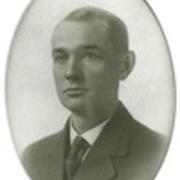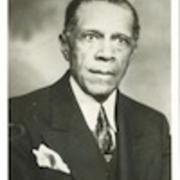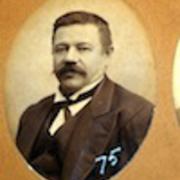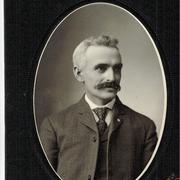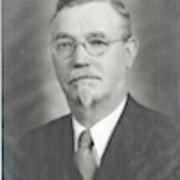
Ginny Lackovic, Architect, interview
An Interview with HGA Architect Ginny Lackovic
by Randy Croce
November 2010
RC: NAME AND ROLE IN THE PROJECT?
That’s Ginny Lackovic. And that’s G-I-N-N-Y. L-A-C-K-O-V-I-C. And I’m an architect with HGA [HGA Architects and Engineers]. A, it’s, it’s an interesting project. It’s, it comes under the heading of asset preservation. Um, it’s, it’s a way of actually making progress, a, at a much smaller level, incrementally to, to move a, a full restoration forward. And so our participation began back in 2005, um, as a much larger project. We were actually hired to do an interior restoration, a full restoration of the interior. A, that project did not move forward, but one of a, the benefits from that project is that we actually launched several asset preservation projects. And so the current one is the dome restoration which has its roots as an interior project, the a plaster damage, a water- related plaster damage in the rotunda area is really what kicked this project off. And so what we’re focusing now on is water intrusion, a mitigating it, slowing down the water that actually penetrates the dome as a way to try to salvage and, and maintain the a, integrity of the building exterior. So this project actually a, focused on joints at the, repairing joints, a at the drum and dome. And as part of that, that was the first step is just keeping water out. Um, it really... Once the water gets in then you’ve got a whole different range of problems, but um... So the first step is to keep it out. So we actually repointed a, the entire drum and dome and as also as part of that, there’s a fair amount of stone deterioration, a that we see with, especially with the white Georgian marble that we’re also trying to pick up a, and incrementally repair as we can. So that’s the basis of it is keeping the water out. Um... There were also several other strategies that we employed once..., assuming that some water will always get in. A, that was Cass Gilbert’s assumption. It hasn’t changed. He was right about that. Water will get in, it’s how you manage it once it does get in, what do we do and how do we um, help the building dissipate that water. How do we redirect it? How do we recapture it? How do we control it at some level. And so several other strategies were then a, implemented on the inside to help dry the building out. So you’ll see some additional a, mechanical a work that was put in, in the middle dome area, a to help circulate air and, and again, help the building dry. So that is it in a nutshell for the dome. Do you want me to keep going on some of the smaller aspects of the project?
Well the original construction is interesting and you know I think a big part of what they struggled with initially a, is still haunting us today. It’s, you know, what was the best way to construct the outer dome? Cass Gilbert certainly had a vision for the building. Um, and again I, I’m not sure at that time they anticipated buildings lasting 100 years? I mean was it... It’s supposed to be a 50-year building, a 70-year building, a 100-year old building. You know how long did they actually, did he project. And that we don’t know what his expectations were, but clearly he a chose a material that um, is a bit challenged in this climate. Um, the marble is beautiful and this building must have just been spectacular when it opened. Um, (clears throat) over time that gleam and that polish is (clear throat) starting to where off as the stone weathers. And you know it’s, it’s a terrible roofing material. So as an interior material it’s, it’s beautiful, it’s wonderful, you can keep it polished. You can keep it clean. It’s very durable, a very resistant to a lot of where and tear, but as an exterior a, surfacing material, it’s not so good. So... And I think that they, they anticipated some of the problems that we’re seeing today and several a... There were several design a, details that were implemented to capture, capture water and, and direct water out of the building. Um, he actually... There are several letters where he, during correspondence with his engineer and the state, admits that the building will leak. I mean and he, he accepts that and then took another step though to, to actually work with that and, and to make it the best that it could be given the fact that it would still leak. And a, we are still fighting some of those battles now where, as the material continues to age a, the, the details that were put in place initially could handle a fair amount, a modest amount of water, but the amount of water that we’re seeing today would, a hundred years of deterioration is a, the systems don’t handle it as well. And that’s what we’re dealing with now is how do we take a building that has now aged significantly and is, you know, in some cases some of the materials are approaching the end of their serviceable life and how do we deal with that um inevitability of, you know, that replacement may at some point be necessary. In the meantime, how do we, how do we keep limping along with materials that are definitely compromised at some level. So it’s a struggle. It’s a little bit of a challenge to try to um, maintain as much as, of the original as you can without compromising the integrity of the, of the building envelope. And at some point there’ll be some very difficult decisions that the State will have to make in terms of, you know, when do we, when do we say that this is it and, and start looking at actually wholesale replacement instead of doing the repairs. That hopefully is several years out, but um, it’s gonna be a big decision when it’s made. And a lot you know, again I think you can break the building down into pieces. There’s the pieces that are less detailed a um, panels that are more solid and flush. And those are actually holding up pretty well. Um, it seems what we’re noticing is that the more tooling that a piece of marble has the more proud it is to advance, deterioration and weathering. And so the really highly carved, very ornate pieces are the ones that we’re actually gonna lose first. And of course those are the ones that give the building its character and, and that’s always a hard decision to make. But that’s what we’re seeing are the column capitals and some of the decorative figurines, um, are definitely are the ones that have taken the, more abuse over the years. So...
RC: AS A LIVING THING, IT HAS TO BE CONTINUALLY RENEWED.
Well that is... I mean the building starts to deteriorate the, the day it’s turned over to the owner. I mean as soon as it’s constructed, that’s, now the maintenance program begins. It, it... I think there’s often a myth that with a stone building that it’ll last forever, and um, and that’s really not the case. Um, no matter what construction material you’re working with, deterioration starts immediately. And it’s an ongoing process. And the longer maintenance is deferred the, the more accelerated that process becomes. And, you know, this building’s gone through several um, significant, a restoration or repair campaigns. Um, the roof’s been replaced several times. A, it’s been repointed many, many times, a over the years. Not often enough. But a, and, and I think what happens is you see it and it’s, it’s a hard thing for building owners um, to get their arms around is that those maintenance schedules, the time between events, shortens as the building ages. A, so you know you may get by for 20, 30 years without having to do anything really major. There will be small things, but then after that, you know, maybe it’s only 20 years. And then after 50 years you’re down to a 10-year period where you have to start paying attention. And I think what the State is... What we’re seeing with past projects here is that to every 10 to 15 years you, you end up doing a fairly major overhaul of some of the, the majors systems. And again, part of that has to do with the marble, the, the aging marble and just the nature of that material, it’s difficult to keep joint fill, joints filled whether that’s mortar or sealant. It’s difficult to maintain those joints over an extended period of time. Um, a typical building that doesn’t see the kind of movement that this one sees a, you can probably get by with a, you know a 10 to 15-year cycle. This one is, is probably a more comfortable timeframe would be 5 to 7 years. Um, and that’s pushing it. Um, I mean the building moves, especially the dome um, given its exposure to sun and, and temperature swings, a there’s a substantial amount of movement. And a, to maintain joints here, they, they fail very quickly. And that’s... It’s, it’s been a problem. A, it’s an ongoing problem and it’s one of the reasons that we’re here now is that, almost complete failure of the joints that were put in. And I believe the last a, repointing previous to, to 2010, un there was some piecemeal repointing, some very specifically repointing of ribs (?) done, five years ago. But the actual mortar replacement probably the last repointing was done in the mid-90s. So that’s enough time that a, a tremendous amount of water has been coming in through failed joints. And, and it’s one of those things, it’s, it’s an ongoing... It’s an ongoing process. It’s a living building. It, you know, we just restore joints today. In another month or another year, you will already see a failure at some level at some areas. It’s just a given. It’ll happen. It’s just a matter of when. So I think, you know, the key to any building, especially one that has the historic importance that this one has is, is continued vigilance, a, a maintenance program, un is absolutely critical to maintaining the health of the building. You have to come out and look at every system on a regular basis and catch things before they become cataclysmic failures. A, it’s always better to be proactive, rather than reactive. And that’s... Again, it’s a hard thing to sell to people who have a limited budget and limited resources, to do maintenance. Um, it’s... I think people have gotten into a cycle here where, you know, responding to crisis as they come up, rather than um, responding to a, a regular cycle where you know it’s been five years. We gotta redo the joints. You know, even if they’re not leaking, they need to be redone. And that’s something that a, is a hard thing to, to retrain people to do. But that’s where we’re at on this one is it’s, it’s a... A, again there... What happens on a building like this too over time, a building of this scale and this size is that projects are done incrementally. And um, when the building is constructed everything is new at one time. But over time, a, different pieces of the puzzle are, are repaired and, and dealt with at different times. So now everything is out of phase. And so a roof, you know a roof may get redone, but maybe repointing doesn’t happen at that same time. So things are now out of, off schedule and someone has to follow up on that. And it becomes a very difficult juggling act as, as time goes on to keep up with every single building component. And that’s where having a, a good maintenance program and a staff that is committed to that is important. But a... ‘Cuz it, it doesn’t... It, it happens fairly quickly that everything, you know, it falls out of sequence and a, and that’s when the response to crisis starts to happen instead of, you know, you’re no longer going to have that luxury of everything is new and we’ll just wait and we’re good. So as soon as things start to go wrong, that’s when, that’s when things start happening and a, some systems take longer to figure out that there’s something wrong, than others are much more obvious.
RC: QUALITY OF WORKMANSHIP OF THE ORIGINAL STRUCTURE?
Well it’s an amazing building. And, and the stonework, I think, is really impressive. When um, when you think about some of the pieces that are at incredible heights, I mean a lot of the dome um, is built of... Some of the elements up there at the level of the eagles are 12 feet, 12 feet wide, 5 feet deep and, or you know, 5 feet high, 5 feet deep, 3 feet high. I mean these are immense pieces, single pieces. Um, each one hand-carved, ornately carved, a probably on site and then hoisted up to that level. Um, and then all fitted together and it’s, it’s hard to right now to convince someone that they need to replace a, a small piece, you know because it’s difficult, let alone actually constructing with the sizes and the scale, um, at that scale that they were dealing with when the building was built. I mean it is phenomenal to see how everything fits together. And the dome itself, I think there again, there are very... We’ll go back to the construction a little bit because I think this is part of it. You know it’s... The marble is self-supporting. It’s one of only four self-supporting domes still standing. And... So there was a com, com, a, a pretty a... It was a pretty brave, pretty heroic effort on, on everyone’s behalf, on, on the architect’s, Cass Gilberts, to have to a have that kind of a confidence that his system was going to work and to fight the engineers who disagreed with him completely at that point, whether it would work or not.
But to take a system that was not necessarily tried and true. This wasn’t conventional building. Um, this isn’t something that had been tried before, a or had not had a lot of... I mean there weren’t that many domes built that were self-sustaining, or self-supporting. And so to, to move forward with something that’s not conventional with a material that is, again is not local. These are not... This is not something that people, laborers here had a lot of experience with. Um, and then to, to move forward at the scale is, is pretty amazing. And a, again, given a, a, the a, the tools and, and tools of the trade and just availability for hoisting and, and moving quantities like that it, it just is baffling to me today knowing what we struggle with with all of the advantages we have um, by comparison. Oh my gosh. (laughs) It’s, it’s, it’s an amazing a, undertaking. And it’s, it a... In spite of the a, a a lot of the conversation that’s happening right now about the deterioration of the material, um the tooling of it and the, the craftsmanship that went into it is, is really why the building has held up as well as it has. Um, the detailing is, is amazing. Um, you know every piece sheds water and some very subtly, but, but still it, every, every single inch of the building was designed with intent. And, again, at the scale of the materials um, that’s, it’s an amazing. It’s amazing to see that it, one, that everything was covered. Because the drawing said... I mean again, drawings that at that point had maybe a hundred sheets. Maybe not even that many for this building. Um, compared to what we would issue now to build a building like this would be a four-volume set of a hundred sheets each. So I mean there... Buildings at this time, I mean you relied a lot on the craftsman, on their knowledge and, and their sensibilities. Um, I mean there are often, or often comments that, that say you’ll do it this way and then, you know, it’ll take you up to a certain point and then it’s, you know, using typical methods. A, and what are those? You know they didn’t describe them at that point. They just relied on, on craftsman and trades, a the trades to actually carry that through, carry that forward. And so there’s, there was a lot of trust and there was a lot of um, a lot of field adjustment and a lot of field ingenuity that went into these buildings. And you can actually see that in this one as um, if you compare the basement plan to the actual drawing it is right on, dead on, almost I would say 95% of what is laid out... What, what you can see today is actually right exactly as dimensioned on the plan. By the time you get up to the dome level though, there are no drawings. A, that we’ve, we’ve never found a drawing that shows the actual construction of the dome. There’s a drawing that shows the intent, but that’s not what got built. So at some point there was an adjustment made. Um, there was a lot of arguing between the architect and the engineers, contractors and the State at that point. Um, and the dome... Actually the dome was not installed. I think the top of the drum wall was finished and sat vacant without a dome for several months until they resolved some of the issues. And at that point, again, it was basically verbal communication um, between Cass Gilbert and, and some of the people that were doing the construction. But there are no drawings that show exactly what it is now. We have a couple sketches that we found in New York, but there are very... There is no formal drawing that we ever found that shows exactly how that’s built. And so that’s... That tells you a lot about a, again, you know, decisions made in the field and, and kind of field gymnastics and trust that you have with a contractor. And I think at some point... By that time I believe Cass Gilbert had moved out of Minnesota and was living in New York. And so I think a lot of the decisions were being made locally by the contractor and tradesmen. And so it’s, it’s... Again you can see that, that gradual transition from, you know, original plans of this is where we start, but then as, as the building goes up and tolerances change and it’s a much more... It’s a much looser construction when you get towards the top. And even the detailing, a, even that changes, you can see over time where it’s drawn very specifically and with intent. A, the animal motifs are, are, that actually were drawn, were not carried through. And it would be interesting to see at what point and, and how those morphed into what they actually are. But there are a lot of changes, subtle changes that were made along the way that probably were re, in, in response to artistic sensibilities and, and just available talent. Someone might not have liked the buffalo and so therefore it became a... I think we have wolverines and farm animals where there were once buffalo heads actually drawn. So changes along the way.
RC: BESIDES THE STONE WORK, ARE THERE OTHER INNOVATIVE/PROVACATIVE CRAFTSMANSHIP EXAMPLES?
You know I, I haven’t spent a lot of time in the building. You know I’ll work... My work, initial was focused on behind the scenes structural, a work. Still don’t really know the interior of the building. Although there are areas um, again they had some very, Garnsey was a very well known muralist at the time so those, the murals are beautiful. And a, and again I don’t have much of the history on him, um, but a, again at that scale, they, they had some very talented people working. Um, and you know as far as other trades, you know this building is really a, a monument made of stone. I mean it, it is about stone. The exterior is, is about stone. The interior is also stone. There’s very... There’s 38 different types of marble, but one type of wood. Um, and so yeah it’s... It... I think in Cass Gilbert’s scheme, um, it was let the material do... You know, the material stands on its own. There wasn’t a lot of fussy detailing and, and decorative woodwork on the inside. Stone was enough um, I think in his opinion. You know it carried it on its own. There wasn’t a lot of competing paint schemes or, or decorative wood or carvings. Um, the, the stone was it. And it’s, it’s interesting when you compare this capitol to other capitols that have less stone, you know what, what did they do to get that same level of, of monumental, monumental elegance or, or you know, impressive... And you know a lot of other capitols relied on murals and a garish paint schemes, and a, a lot of different wood. And I think if you were to do a, a, a... If you were to do a, a comparison state to state, you know it’s whatever your resources were or whatever your local talent was, that was showcased. That being said, I think this is a little unique in that Cass Gilbert had very high aspirations for this building and a, and was just not going to be talked out of (laughs) out of his a original scheme. So I think of... A, maybe our second state capitol and even the first were probably more reflective of, of what some of the others are, a, another national capitols. A, this one is really unique in terms of the others that I’ve seen, a just its scale and its commitment to this kind of monumental material. Um, and so his... You know it’s... The rest of the building is, is fairly I, I... Modest is probably not the probably not the right word. But, again it’s all white oak. Um, but that’s it. It’s white oak. And it, and it... Everything is very linear. There’s not a lot of decorative carving in any of the woodwork. The a, there, there are some decorative metal which is quite beautiful. The railings are quite beautiful. And that brings a little bit more of the personal history of Minnesota a, into the building, more the, more than he could do with the stone. So I think there’s, there was probably some time spent um, developing those motifs. But really it’s, it’s the rotunda is very grand and very beautiful with the murals and the, the story that that tells a, is the centerpiece. And then from there it um, the stone does the rest. But... Yeah but it, it really is... It’s a very masculine building. I, I hate to use that, that term, but um... But it’s not... It... There’s not a lot of, of elegant fussy detail. It, it’s very bold. It’s very geometric, um very strong in its, in its character. And that’s carried all the way through.
RC: DID YOU FIND ANY TOOLS FROM PAST LABORERS?
Well yeah I, I don’t know that at this point... You know again, this is not the first renovation or the first restoration. So um, and, and the building has been inhabited continuously. So, you know, in terms of discovery there’s, there’s probably... The... I don’t know that there’s been a lot of discovery of tools. A, you know there’s... There were several ladders that were left over from the original construction up in the dome, just because they were too big to remove once the dome was actually finished. And, and they were... They were trapped. Um, I think that those have now been cut, cut out and I think they’re gone now unfortunately. I would have liked to have kept those right where they, right where they were, but I think in order finish the a, the waterproofing work those, those actually were needed to be removed. Um... But there really um... I think, you know, the interior spaces, again, the building was built out a, fairly early on. Um, there were not a lot of unexcavated, un, underutilized spaces. So, since everything was planned and used, I, I... There weren’t that many tools left behind other than the, the, an occasional ladder, um, that you’ll see tucked away up in the dome. A, I think maybe more interesting are all the, the, the carvings of all the initials over the years of, of all the people that have been here that have worked on it. Um, but yeah there, there may still be opportunities to find things in, in the areas that are difficult to access, the attic spaces, you know where people have dropped things out of pockets. I may be there be a treasure trove up there still yet to be discovered. But um... I don’t think this building is, is like a, like some of the others that go through private ownership changes or like theatres that have a lot of underutilized space that’s difficult to get to, um, and, and stage hands hide out there to do their drinking. Um... I, I think this building’s a little bit different than, than that and, and so I, I don’t know that many stories of things that have been found or discovered. I think there was a, a little niche, kind of a hidden, a place down in the basement somewhere where one of the staff used to hide. And yeah, there’s, there’s apparently... Someone found some letterhead, an old letterhead. And a, again a little bottle of, of a, hooch and a, I think there was some, several other things that may have been, have been in this area that had been blocked in and was unknown. But that also could be a wife’s tail that they’re telling to. I don’t know. So...
RC: DISCUSS THE LADDER USED TO CHANGE THE LIGHT BULBS.
Yeah that was a... Well it’s... The light, changing of the light bulbs is one of the, you know it is an event here. Um, the incandescents. The building is just full of them and many of them are in places that are absolutely impossible to get to. Um, and I think the area that you’re referring to is the rotunda. You know there is a series of light, a lighting fixtures that a, ring the rotunda at the third floor balcony. And the only way to access them, a, today we use... We actually... The state hires the flag pole repair people because they, they actually are one of the few who have the kind of insurance that will allow them to work in places like this. Prior to that, there was a ladder that had a, that had looped over steal a, anchors that would just clip on to the balcony, and then you just... It was basically a, a, a leap of faith almost, where you had to crawl over the edge and, and go down several feet to change the light bulb. But if you lost track of where you were, there is (laughs)... The end of that ladder is, is a long way down. And a, I think the ladder actually overhung that balcony, I think maybe 7, 8 feet. And a, and then you, you’d move it to the next light bulb and move it to the next light bulb. And that ladder is still actually up there. They no longer use it, but a, again its, it’s another one of those ta, ta maintain this building and to continue to operate this building is, has always been a challenge. It’s, it’s, it’s... To change a light bulb today in the grand stairway, it’s a good 40 minutes if you, if you were to leave the basement for Dave the building guy, for him... If he were to leave his desk, it takes about 40 minutes to get up... By the time you take the path through the, up the stairs and into the attic, up, and over and through and around all the mechanical, into the next space, it’s, it’s a 40-minute trip to change one light bulb. So they don’t do it very often. And a, they tend to let them burn out and then do several of them at one time. But they also... You, you’ll see when you get up into these spaces is, is, there’ll be piles, piles of empty light bulb cartons ‘cuz it’s a long way up, it’s a long way back and no one ever, you know.... A lot of them get hauled up and left, but very little of that debris ever comes back out. So there’s a, an entire a, history of light, lighting I think up in a lot of these attics just on a, based on cartons alone. There’s tons of lighting-related junk up in the attic spaces. But it’s, it’s a very difficult... It’s a very difficult building to, to operate in that sense. Um, there are just a, a lot of places are just not accessible by latter, and um, or by skip. So it requires climbing and rigging to, to get to a lot of this and that just isn’t something that, that gets done on a regular basis.
RC: DISCUSS SAFETY AND THE EARLY SCAFFOLDING. WE KNOW SIX MEN DIED WORKING ON THE CAPITOL ORIGINALLY. PLEASE COMPARE AND CONTRAST THE CONDITIONS OF THEN AND NOW.
Oh that’s... Yeah that’s night and day. Um, I think the level of safety when this building was built was based on everybody’s sense of their own judgment and their own sense of safety, what they were comfortable with. And um, there weren’t probably a lot of measures taken. I mean there were no hard hats. There’s weren’t um... Well maybe... I’m not sure when hard hats became a, a... But certainly the photographs we have that document the construction, it’s not something that was common to see, were, was any kind of protection for, for the head. Um, you know I... The scaffolding was built on site. It was... It wasn’t a, an erector set like we’ve got now where you’ve got standard pieces that go together. Everything was cobbled together using, a whatever was available. A, again it was much more massive than what we have now, but a, again you’re relying on, on a, bits of pieces that are not standardized. And... So scaffolding was... And, and ladder access. A, again everything was just... You basically you climbed where you needed to be. I mean it wasn’t as convenient as, as it is today where um, if, you know the scaffolding that we have... And part of this was to make it easier for the architects and, and a, inspectors and people who were on site that weren’t necessarily the day-to-day a, trades and craftsman that are working on the building. But to have a switchback stair that gets you up five stories, um, vs. a straight ladder, which is typical on, more typical on construction sites, a, the level of safety that, that J. E. Dunn has provided, that, that they can provide today is just so much different from even where we were, you know, 20-30 years ago... But it... (laughs) You know the, the thought of, of climbing a 70 foot straight ladder on a 90 degree day with no platforms and a, safety harness, you know, that was typical. And we actually have a ladder like that here and the guys use it. Um, but they use it at their own risk and they’re trained, and they, you know, they’re used to that. Someone like me coming in that, that doesn’t do this on a daily basis and hates heights, um, you know, um, it’s not something that anybody’s comfortable with. I don’t want to do it and, and a, the, the contractor doesn’t want us doing that. And so there have been several measures that kind of go above and beyond, um, typical safety just so that everybody’s got good access, good safe access. And a, and you know you compare that to where, where things were at when this building was built or, or when a, you know, you see the skyscrapers in New York where they’re having their lunch on the edge of the beam, you know. (laughs) You know there, there was no OSHA. There were... You know again, your safety was your own responsibility and a, if you made a mistake you, you paid dearly for it. And, and here they’re a... The commitment to safety is um, is it’s just night and day where the, there are safety inspectors for the contractor on site weekly making adjustments and making changes. Um, I can’t tell you how many times certain things have changed to just improve safety so that everybody was comfortable. And a... Even things that you were comfortable doing, um, those got to be reworked to make it even better. So it’s... I, I have to say that this job probably more so than any I’ve ever worked on has had a commitment to safety that exceeds anything that I’ve seen. And a, and that’s good. No, we don’t need... So far we haven’t anybody, let alone six so. (Yeah) (laughs) But I think that wasn’t uncommon at that point for people to, again especially when you’re building at this height. I mean the building is 200 plus feet tall. And a,you know, you make one wrong step and that’s... It’s a long way to go. Now it’s gonna... There are still some things that people are doing that, again, if you’re not comfortable and don’t have that skill set, you have no business being out there. And I through that back to McPhearson’s town masons, the guys that are actually repointing the dome that are coming down a, on chairs, Bowsom’s (sp?) chairs, um, that’s not something that everybody is comfortable with and even within that group there are probably only a handful that are willing to take that risk. Again they’re harnessed in. They’ve got safety winds. It’s as safe as we can get for them, but still knowing you’re safe and actually being comfortable out there are two different things sometimes. So um, so there... But yeah it’s, it’s very different. I mean if you look around you, I mean the, the hand rails and the guard rails that are now part of all of these projects are, are there for a reason. I think every, every safety implement you see as you look across the roofs and at the scaffolding is because of some unfortunate accident in the past that now people think about these things and a little bit more seriously and there are organizations that monitor that. They’ve been here. They’ve, they’ve a, they’ve checked up on us. So...
*** END OF GINNY LACKOVIC INTERVIEW
